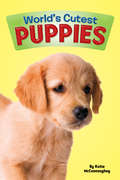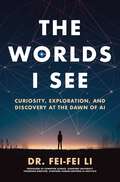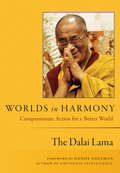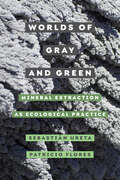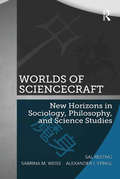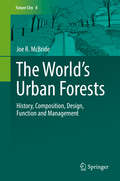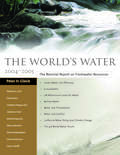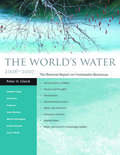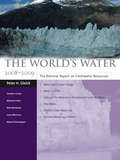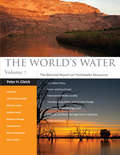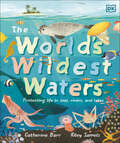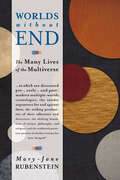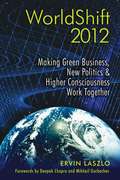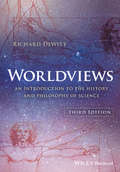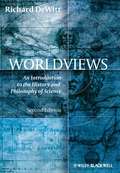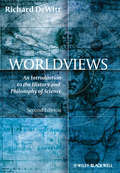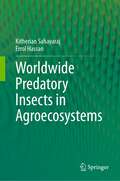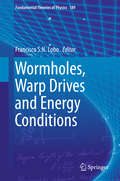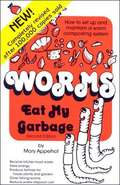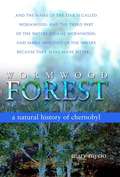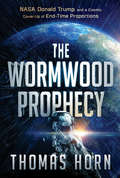- Table View
- List View
World's Cutest: Puppies
by Katie McconnaugheyEnter a world of playful pups doing what puppies love most--exploring, playing, cuddling, sleeping, and more! Fun facts about dogs are paired with precious images of adorable puppies.
Worlds Fantastic, Worlds Familiar
by Buratti Bonnie J.Join Bonnie J. Buratti, a leading planetary astronomer, on this personal tour of NASA's latest discoveries. Moving through the Solar System from Mercury, Venus, Mars, past comets and asteroids and the moons of the giant planets, to Pluto, and on to exoplanets, she gives vivid descriptions of landforms that are similar to those found on Earth but that are more fantastic. Sulfur-rich volcanoes and lakes on Io, active gullies on Mars, huge ice plumes and tar-like deposits on the moons of Saturn, hydrocarbon rivers and lakes on Titan, and nitrogen glaciers on Pluto are just some of the marvels that await readers. Discover what it is like to be involved in a major scientific enterprise, with all its pitfalls and excitement, from the perspective of a female scientist. This engaging account of modern space exploration is written for non-specialist readers, from students in high school to enthusiasts of all ages.
The Worlds I See: Curiosity, Exploration, and Discovery at the Dawn of AI
by Fei-Fei LiONE OF BARACK OBAMA'S RECOMMENDED BOOKS ON AI * FINANCIAL TIMES BEST BOOKS OF 2023From Dr. Fei-Fei Li, one of TIME's 100 MOST INFLUENTIAL in AI, comes "a powerful plea for keeping humanity at the centre of our latest technological transformation" (Financial Times).Wired called Dr. Fei-Fei Li “one of a tiny group of scientists—a group perhaps small enough to fit around a kitchen table—who are responsible for AI’s recent remarkable advances.”Known to the world as the creator of ImageNet, a key catalyst of modern artificial intelligence, Dr. Li has spent more than two decades at the forefront of the field. But her career in science was improbable from the start. As immigrants, her family faced a difficult transition from China’s middle class to American poverty. And their lives were made all the harder as they struggled to care for her ailing mother, who was working tirelessly to help them all gain a foothold in their new land.Fei-Fei’s adolescent knack for physics endured, however, and positioned her to make a crucial contribution to the breakthrough we now call AI, placing her at the center of a global transformation. Over the last decades, her work has brought her face-to-face with the extraordinary possibilities—and the extraordinary dangers—of the technology she loves.The Worlds I See is a story of science in the first person, documenting one of the century’s defining moments from the inside. It provides a riveting story of a scientist at work and a thrillingly clear explanation of what artificial intelligence actually is—and how it came to be. Emotionally raw and intellectually uncompromising, this book is a testament not only to the passion required for even the most technical scholarship but also to the curiosity forever at its heart.
Worlds in Collision
by Immanuel VelikovskyPropounds the theory that more than once within historical times, the order in our planetary system was disturbed and caused enormous cataclysms. From the book: WORLDS IN COLLISION, the most discussed book of our time, propounds the startling theory that more than once within historical times the order in our planetary system was disturbed and caused enormous cataclysms; the earth became a primeval chaos lashed by tornadoes of cinders; the skies darkened; land masses were destroyed and large portions of the human race perished.
Worlds in Harmony: Compassionate Action for a Better World
by Daniel Goleman The Dalai LamaOne of the Dalai Lama's most striking qualities is his genuine interest in Western scientific and social thought. <P><P>He firmly believes that if Buddhism is to have relevance today, it must be flexible and dynamic, able to take in new ideas and adapt to new situations. In Worlds in Harmony, he combines timeless Buddhist teachings with modern Western psychological theory to address such diverse issues as environmental destruction, political oppression, the nature of anger, and the application of Buddhist principles in the West. Writing that insight is of no use unless it results in action, he offers new ways of being, thinking, and acting in the world that are based on equanimity and deep understanding. Worlds in Harmony is a timely source book on the practice of healing and compassionate action in daily life.
Worlds of Gray and Green: Mineral Extraction as Ecological Practice (Critical Environments: Nature, Science, and Politics #11)
by Sebastián UretaThe Anthropocene has arrived riding a wave of pollution. From "forever chemicals" to oceanic garbage patches, human-made chemical compounds are seemingly everywhere. Concerned about how these compounds disrupt multiple lives and ecologies, environmental scholars, activists, and affected communities have sought to curb the causes of pollution, focusing especially on the extractive industries. In Worlds of Gray and Green, authors Sebastián Ureta and Patricio Flores challenge us to rethink extraction as ecological practice. Adopting an environmental humanities analytic lens, Ureta and Flores offer a rich ethnographic exploration of the waste produced by Chile's El Teniente, the world's largest underground mine. Deposited in a massive dam, the waste—known as tailings—engages with human and non-human entities in multiple ways through a process the authors call geosymbiosis. Some of these geosymbioses result in toxicity and damage, while others become the basis of lively novel ecologies. A particular kind of power emerges in the process, one that is radically indifferent to human beings but that affects them in many ways. Learning to live with geosymbioses offers a tentative path forward amid ongoing environmental devastation.
Worlds of ScienceCraft: New Horizons in Sociology, Philosophy, and Science Studies
by Sal Restivo Sabrina M. Weiss Alexander StinglA response to complex problems spanning disciplinary boundaries, Worlds of ScienceCraft offers bold new ways of conceptualizing ideas of science, sociology, and philosophy. Beginning with the historical foundations of civilization and progress, assumptions about the categories we use to talk about minds, identities, and bodies are challenged through case studies from mathematics, social cognition, and medical ethics. Offering innovative approaches to these issues, such as an integrated social brain-mind-body model and a critique of divisions between the natural and technological, this book provides novel conceptions of self, society and an emerging ’cyborg’ generation. From the micro level of brains and expanding all the way out to biopolitical civics, disciplinary boundaries are made permeable, emphasizing the increased need for interdisciplinary scholarship. By rejecting outdated and restrictive categories and classifications, new horizons in studies of science, technology, and medicine can be explored through the incorporation of feminist, international, and postmodern perspectives. A truly interdisciplinary examination of science and technology as cultural phenomena, Worlds of ScienceCraft will appeal to scholars and students of science and technology studies, as well as philosophers, historians, and sociologists of science, technology, and medicine.
The World’s Urban Forests
by Joe R. McBrideThe purpose of this book is to examine urban forests in cities around the world. It will ask questions about the history, composition, structure, and management of trees in urban areas. Data for this book was collected in 33 cities across broad geographical areas known as biomes. Constraints and opportunities imposed on urban forest composition, design, and management by the ecological characteristics of these biomes will be examined. The book will also address the cultural and historical factors that influenced the characteristics of urban forests around the world.
The World's Water 2004-2005: The Biennial Report on Freshwater Resources (The World's Water)
by Peter H. Gleick Pacific Institute Catherine Hunt Dana Haasz Nicholas L. Cain Christine Henges-JeckThe quality and availability of fresh water are of critical importance to human and ecosystem health. Given its central role in the functioning of all living systems, water is arguably the most important of all natural resources. Produced biennially, The World's Water provides a timely examination of the key issues surrounding freshwater resources and their use. Each new volume identifies and explains the most significant current trends worldwide, and offers the best data available on a variety of water-related topics. This 2004-2005 edition of The World's Water features overview chapters on: conservation and efficiency as key tools for meeting freshwater needs; bottled water quality, costs, and trends; United Nations millennium development goals; groundwater issues; case studies of water privatization; the economic value of water; California water policy and climate change. The World's Water is the most comprehensive and up-to-date source of information and analysis on freshwater resources and the political, economic, scientific, and technological issues associated with them. It is an essential reference for water resource professionals in government agencies and nongovernmental organizations, researchers, students, and anyone concerned with water and its use.
The World's Water 2006-2007: The Biennial Report on Freshwater Resources (The World's Water)
by Peter H. Gleick Heather Cooley Meena Palaniappan Andrea Samulon Gary H. Wolff Emily LeeProduced biennially, The World's Water provides a timely examination of the key issues surrounding freshwater resources and their use. Each new volume identifies and explains the most significant current trends worldwide, and offers the best data available on a variety of water-related topics. The 2006-2007 volume features overview chapters on: *Water and terrorism *Business risks of water *Water and ecosystems *Floods and droughts *Desalination *Environmental justice and water The book contains an updated chronology of global conflicts associated with water as well as an assessment of recent water conferences, including the 4th World Water Forum. It also offers a brief review of issues surrounding the use of bottled water and the possible existence of water on Mars. From one of the world's leading authorities on water issues, The World's Water is the most comprehensive and up-to-date source of information and analysis on freshwater resources and the political, economic, scientific, and technological issues associated with them.
The World's Water 2008-2009: The Biennial Report on Freshwater Resources (The World's Water)
by Peter H. Gleick Heather Cooley Meena Palaniappan Jason Morrison Mari Morikawa Michael J. CohenProduced biennially, The World's Water provides a timely examination of the key issues surrounding freshwater resources and their use. Each new volume identifies and explains the most significant trends worldwide, and offers the best data available on a variety of topics related to water. The 2008-2009 volume features overview chapters on: * water and climate change * water in China * status of the Millennium Development Goals for water * peak water * efficient urban water use * business reporting on water This new volume contains an updated chronology of global conflicts associated with water, as well as brief reviews of issues regarding desalination, the Salton Sea, and the Three Gorges Dam. From the world's leading authority on water issues, The World's Water is the most comprehensive and up-to-date source of information and analysis on freshwater resources and the political, economic, scientific, and technological issues associated with them. It is an essential reference for water resource professionals in government agencies and nongovernmental organizations, researchers, students, and anyone concerned with water and its use.
The World's Water Volume 7: The Biennial Report on Freshwater Resources (The World's Water)
by Peter H. Gleick Heather Cooley Michael J. Cohen Lucy Allen Juliet Christian-Smith Matthew HebergerProduced biennially, The World's Water is the most comprehensive and up-to-to date source of information and analysis on freshwater resources. Each new volume examines critical global trends and offers the best data available on a variety of topics related to water. Volume 7 features chapters on U.S. water policy, transboundary waters, and the effects of fossil fuel production on water resources, among other timely issues. Water briefs provide concise updates on topics including bottled water, The Great Lakes Water Agreement, and water and security. The World's Water is coauthored by MacArthur "genius" Peter H. Gleick and his colleagues at the world-renowned Pacific Institute. Since the first volume was published in 1998, the series has become an indispensable resource for professionals in government agencies and nongovernmental organizations, researchers, students, and anyone concerned with water and its use.
The World's Wildest Waters: Protecting Life in Seas, Rivers, and Lakes
by Catherine BarrA beautifully presented entry point text about our oceans and other watery worlds for 6 years and upDive into the world&’s wildest oceans, lakes, and rivers, and get ready for an underwater adventure!Embark on the journey of a lifetime to 20 of the world&’s wildest waters! Explore each environment and learn about the people who are working to preserve them for future generations. Meet the creatures who call these watery worlds home and discover how you can take active steps to make a difference. Featuring colorful original illustrations and stunning photography, The World&’s Wildest Waters brings the excitement of the high seas and the mystery of the ocean&’s dark, hidden depths to your lap.
Worlds without End: The Many Lives of the Multiverse
by Mary-Jane RubensteinA religion professor elucidates the theory of the multiverse, its history, and its reception in science, philosophy, religion, and literature.Multiverse cosmologies imagine our universe as just one of a vast number of others. Beginning with ancient Atomist and Stoic philosophies, Mary-Jane Rubenstein links contemporary models of the multiverse to their forerunners and explores the reasons for their recent appearance. One concerns the so-called fine-tuning of the universe: nature's constants are so delicately calibrated that it seems they have been set just right to allow life to emerge. For some thinkers, these "fine-tunings" are evidence of the existence of God; for others, however, and for most physicists, "God" is an insufficient scientific explanation. Hence the multiverse&’s allure: if all possible worlds exist somewhere, then like monkeys hammering out Shakespeare, one universe is bound to be suitable for life. Of course, this hypothesis replaces God with an equally baffling article of faith: the existence of universes beyond, before, or after our own, eternally generated yet forever inaccessible to observation or experiment. In their very efforts to sidestep metaphysics, theoretical physicists propose multiverse scenarios that collide with it and even produce counter-theological narratives. Far from invalidating multiverse hypotheses, Rubenstein argues, this interdisciplinary collision actually secures their scientific viability. We may therefore be witnessing a radical reconfiguration of physics, philosophy, and religion in the modern turn to the multiverse.&“Rubenstein&’s witty, thought-provoking history of philosophy and physics leaves one in awe of just how close Thomas Aquinas and American physicist Steven Weinberg are in spirit as they seek ultimate answers.&”—Publishers Weekly&“A fun, mind-stretching read, clear and enlightening.&”—San Francisco Book Review
WorldShift 2012: Making Green Business, New Politics, and Higher Consciousness Work Together
by Deepak Chopra Ervin Laszlo Mikhail GorbachevA handbook for conscious change that could transform the current world crisis into planetary renewal • Outlines the problems that make today’s world prone to breakdown and suggests actions we must adopt in politics, business, and everyday life • Replaces the limited consciousness of our failing society with the holistic consciousness that is rooted in the Akashic field The deepening economic crisis and the threat posed by climate change and other social and ecological trends has caused many to despair. But with great danger comes great opportunity--the opportunity for fundamental change that will transform our societies from top to bottom. In WorldShift 2012, Ervin Laszlo brings together insights for creating sustainable positive change from spiritual leaders, scientists, and visionary businesspeople--people such as Albert Einstein, Mohammad Yunus, Václav Havel, Eckhart Tolle, Ken Wilber, David Korten, Paul Hawken, and Tomoyo Nonaka, former CEO of Sanyo Electronics. He shows how we can replace the limited consciousness of our failing society with the holistic consciousness that is reflected in the unified field of quantum physics: the Akashic field. We have an opportunity to move from the current political and business model of grow or die to a sustainable world respectful of human beings, nature, and the planet. Change on this level calls for a profound shift in consciousness and a clear understanding that--as cutting-edge physics shows--we are truly connected with each other and with the cosmos. This book presents clear evidence of this connectedness and describes the tools we need to make our world greener and our planet safer as we strive to realize the holistic consciousness of connection through the Akashic field.
Worldviews: An Introduction to the History and Philosophy of Science
by Richard DeWittUnlike many other introductions to philosophy of science, DeWitt's book is at once historically informative and philosophically thorough and rigorous. Chapter notes, suggested readings, and references enhance its value."Choice "Written in clear and comprehensible prose and supplemented by effective diagrams and examples, Worldviews is an ideal text for anyone new to the history and philosophy of science. As the reader will come to find out, DeWitt is a gifted writer with the unique ability to break down complex and technical concepts into digestible parts, making Worldviews a welcoming and not overwhelming book for the introductory reader."History and Philosophy of the Life Sciences, vol. 28(2) Now in its third edition, Worldviews: An Introduction to the History and Philosophy of Science strengthens its reputation as the most accessible and teachable introduction to the history and philosophy of science on the market. Geared toward engaging undergraduates and those approaching the history and philosophy of science for the first time, this intellectually-provocative volume takes advantage of its author's extensive teaching experience, parsing complex ideas using straightforward and sensible examples drawn from the physical sciences. Building on the foundations which earned the book its critical acclaim, author Richard DeWitt considers fundamental issues in the philosophy of science through the historical worldviews that influenced them, charting the evolution of Western science through the rise and fall of dominant systems of thought. Chapters have been updated to include discussion of recent findings in quantum theory, general relativity, and evolutionary theory, and two new chapters exclusive to the third edition enrich its engagement with radical developments in contemporary science. At a time in modern history when the nature of truth, fact, and reality seem increasingly controversial, the third edition of Worldviews presents complex concepts with clarity and verve, and prepares inquisitive minds to engage critically with some of the most exciting questions in the philosophy of science.
Worldviews: An Introduction to the History and Philosophy of Science (2nd edition)
by Richard DewittUpdated throughout and with three entirely new chapters, Worldviews: An Introduction to the History and Philosophy of Science, Second Edition furthers its reputation as the definitive introductory text on the historical developments and philosophical issues that inform our scientific view of the world around us. Represents an innovative introduction to the history and philosophy of science, designed especially for those coming to the subject for the first time Updated new edition features the addition of chapters focusing on scientific laws, evolutionary theory, and implications of evolution Covers the key historical developments and philosophical themes that have impacted our scientific view of the world around us Analyzes the transitions from the Aristotelian worldview to the Newtonian worldview to a new and currently developing worldview Explores challenges to the Western scientific worldview brought on by recent discoveries.
Worldviews
by Richard DewittUpdated throughout and with three entirely new chapters, Worldviews: An Introduction to the History and Philosophy of Science, Second Edition furthers its reputation as the definitive introductory text on the historical developments and philosophical issues that inform our scientific view of the world around us. Represents an innovative introduction to the history and philosophy of science, designed especially for those coming to the subject for the first timeUpdated new edition features the addition of chapters focusing on scientific laws, evolutionary theory, and implications of evolutionCovers the key historical developments and philosophical themes that have impacted our scientific view of the world around usAnalyzes the transitions from the Aristotelian worldview to the Newtonian worldview to a new and currently developing worldviewExplores challenges to the Western scientific worldview brought on by recent discoveries
Worldwide Predatory Insects in Agroecosystems
by Kitherian Sahayaraj Errol HassanThis book brings out the world record of various predatory insects and their role in pestiferous insect management in a safer manner. The main focus of the book is to address the ecological and environmentally safe methods of managing pests of various crops. The utilization of various types of chemical pesticides for our crop protection and food production leads to environmental concerns and health hazards to plants and animals. This book mainly focuses on the distribution and diversity of various predatory insects in different crops. It also sellout the bionomics, biological control potential at a laboratory, controlled fields and natural conditions. Moreover, mass production technology and environmental safety aspects are also highlighted in various chapters. This book is of interest and useful to undergraduates, post-graduates, research scholars and doctoral candidates, extension workers, and agricultural professionals, and also a valuable source of reference to the relevant researchers and students in the region.
Wormholes, Warp Drives and Energy Conditions
by Francisco S. LoboTop researchers in the field of gravitation present the state-of-the-art topics outlined in this book, ranging from the stability of rotating wormholes solutions supported by ghost scalar fields, modified gravity applied to wormholes, the study of novel semi-classical and nonlinear energy conditions, to the applications of quantum effects and the superluminal version of the warp drive in modified spacetime. Based on Einstein's field equations, this cutting-edge research area explores the more far-fetched theoretical outcomes of General Relativity and relates them to quantum field theory. This includes quantum energy inequalities, flux energy conditions, and wormhole curvature, and sheds light on not just the theoretical physics but also on the possible applications to warp drives and time travel.This book extensively explores the physical properties and characteristics of these 'exotic spacetimes,' describing in detail the general relativistic geometries that generate closed timelike curves.
Worms (Houghton Mifflin Vocabulary Reader Accompanies Journeys)
by Gabriel JordanNIMAC-sourced textbook <P><P>Level J DRA 18 Science Strategy-Question <P><P>Lexile: 390L
Worms Eat My Garbage
by Mary AppelhofThis book is a guide to vermicomposting, the process of using worms and associated organisms to break down organic waste into material containing nutrients for plant growth. Essentially, the author explains how your food waste can be recycled into nutrients for your garden and house plants with the help of some little worms. The author outlines how to build and maintain a worm bin, and gives plenty of purchasing options for those who feel overwhelmed at the idea of building their own bin. Chapters include information on the benefits of having a worm bin, how to set one up, what to put in the bin, troubleshooting techniques, scientific names for worms and what to do with the final product. A glossary, bibliography and index are included.
Worms (Nature's Children)
by Jen GreenIn this book you will learn about the various families of worms, how worms travel, what they eat and how they reproduce.
Wormwood Forest: A Natural History of Chernobyl
by Mary MycioWhen a titanic explosion ripped through the Number Four reactor at the Chernobyl Nuclear Plant in 1986, spewing flames and chunks of burning, radioactive material into the atmosphere, one of our worst nightmares came true. As the news gradually seeped out of the USSR and the extent of the disaster was realized, it became clear how horribly wrong things had gone. Dozens died--two from the explosion and many more from radiation illness during the following months--while scores of additional victims came down with acute radiation sickness. Hundreds of thousands were evacuated from the most contaminated areas. The prognosis for Chernobyl and its environs--succinctly dubbed the Zone of Alienation--was grim. Today, 20 years after the worst nuclear power plant accident in history, intrepid journalist Mary Mycio dons dosimeter and camouflage protective gear to explore the world's most infamous radioactive wilderness. As she tours the Zone to report on the disaster's long-term effects on its human, faunal, and floral inhabitants, she meets pockets of defiant local residents who have remained behind to survive and make a life in the Zone. And she is shocked to discover that the area surrounding Chernobyl has become Europe's largest wildlife sanctuary, a flourishing--at times unearthly--wilderness teeming with large animals and a variety of birds, many of them members of rare and endangered species. Like the forests, fields, and swamps of their unexpectedly inviting habitat, both the people and the animals are all radioactive. Cesium-137 is packed in their muscles and strontium-90 in their bones. But quite astonishingly, they are also thriving. If fears of the Apocalypse and a lifeless, barren radioactive future have been constant companions of the nuclear age, Chernobyl now shows us a different view of the future. A vivid blend of reportage, popular science, and illuminating encounters that explode the myths of Chernobyl with facts that are at once beautiful and horrible, Wormwood Forest brings a remarkable land--and its people and animals--to life to tell a unique story of science, surprise and suspense.
The Wormwood Prophecy: NASA, Donald Trump, and a Cosmic Cover-up of End-Time Proportions
by Thomas HornDoes the Bible predict an asteroid…or something else? This book will challenge your interpretation of end-times theology and help you sharpen your understanding in light of current times. Does Revelation 8:10–11 describe an asteroid? Is the Wormwood star from Revelation 8 already headed toward Earth? Are NASA and high-level government officials aware of an asteroid that is on a collision course with our planet? Is that why President Trump sanctioned a colossal increase to planetary defense? Do the prophecies from ancient cultures and religions across the globe all point to a catastrophic planetary event that has scientists and politicians taking extreme preventative measures under the public radar? Earth is not currently prepared for the scope of impact that may be just around the corner, and people in high places know it… But what will the biblical Wormwood actually be? Traditional scholarly interpretation claims it will be an asteroid. Others postulate that the eschatological poisoning of one-third of all Earth's waters and the devastation of our planet's ecology might not be as detectable as we may believe: it could hit suddenly and without warning, like an angel of God appearing in the sky with fire and light, bringing judgment in an instant. Follow Thomas Horn as he blazes a trail through these questions and many others, posing answers that very few in the church today are willing to provide.FEATURES AND BENEFITS:Examines asteroid threats to Earth, including Apophis (named after the Egyptian god of chaos), which is a topic of serious discussion among experts in planetary defenseIncludes interviews with government impact specialists, scientists, Bible scholars, and prophecy experts
